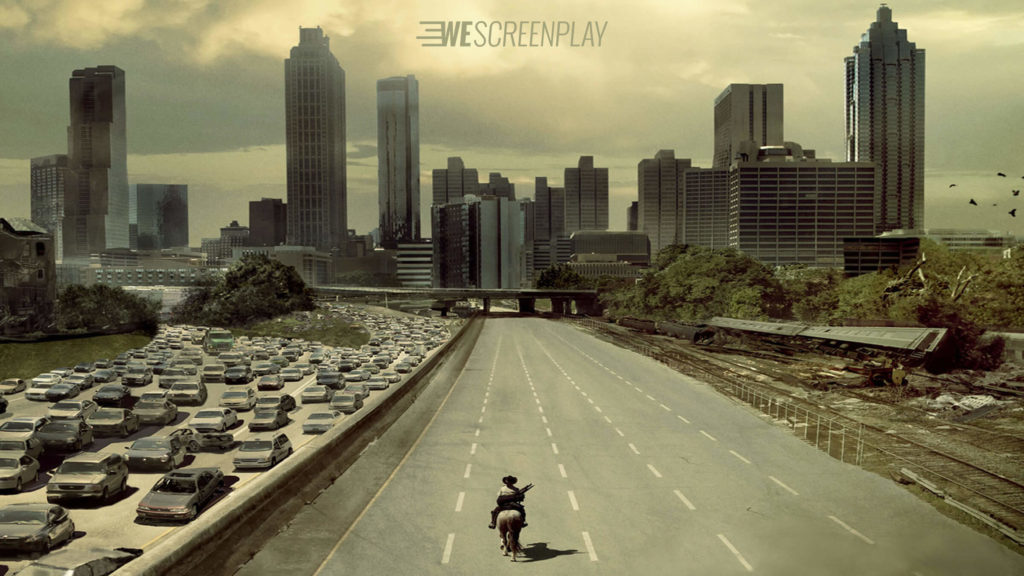
After you’ve read a lot of pilots (and if you’re writing pilots, you definitely should be reading them!), you start to really appreciate the ones that stand out for their excellence, ingenuity, and efficiency. When I first read The Walking Dead by Frank Darabont, I devoured it — talk about a page-turner. With so many great TV pilot competitions for emerging screenwriters and the TV fellowships leaning more and more towards original pilots, it’s smart business to study what works well in a great script. And we’re going to do that right now with this pilot script breakdown of The Walking Dead.
So bar the doors, lock up the dead, and let’s check out what makes Darabont’s script so stellar.
The First Three Pages
If you’re familiar with John August and Craig Mazin’s podcast Scriptnotes, you may recall their running Three Page Challenge wherein they break down listeners’ first three pages — the good and the bad. The reason they chose the first three pages is that it is critical to capture your reader’s attention as quickly as possible to keep their interest. Let’s see a quick look at the first half of his first page:
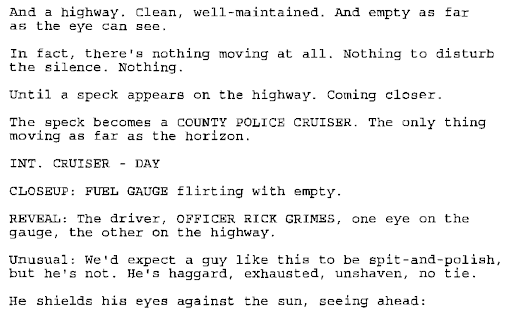
Darabont immediately builds tension and curiosity by opening with a highway that is “empty as far as the eye can see.” He wastes no time in conveying that something just doesn’t feel right. That eeriness lends to human curiosity and poses questions for the reader: what happened here?
It also builds danger for the protagonist — heightened by a fuel gauge that is “flirting with empty.” Rick Grimes is alone on an eerily abandoned highway in a car that is running out of gas and threatening to leave him further exposed.
Notice also that Darabont is comfortable having a little fun with his wording. That “flirting with empty” phrase is clear and succinct and a little more interesting than the more standard “running on empty.”
He also boldly tells the reader that something is “unusual” — by subverting the expectations of an officer (“spit-and-polish”) and making Rick “haggard [and] exhausted,” Darabont doubles down on communicating that something is wrong. Something bad happened. And the reader will innately want to know what it was.
Over the second page, the danger heightens. There are corpses in cars and a creepy shuffled-foot little girl that he only catches glimpses of from the vulnerable position of looking under vehicles. Page two completely builds tension and it becomes impossible to look away.
On page three it’s finally revealed to Rick — and to us — that the girl is dead and a danger. She advances on Rick and he defends himself by shooting her. But instead of finally being safe, he finds himself in even worse danger:
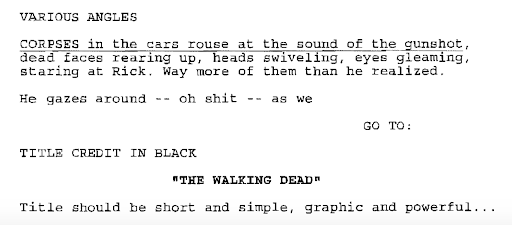
Now surrounded by alert corpses with “heads swiveling [and] eyes gleaming,” Darabont wraps up his teaser and cuts to TITLE CREDIT IN BLACK before his third page is done.
No reader is gonna put this script down.
Pacing
After the credits, the pilot flashes back to begin to explain how Grimes got to be in his situation. It’s sort of like starting a film in the middle of a battle and then showing a “twenty hours earlier” title card.
A quick note on this: The Walking Dead came out in 2010. In the years since it’s become especially popular to open a screenplay with a time jump. As a result, these can often feel cliché. This is not to say that you should not use them — but if you do, make sure it is excellent. You’re competing with The Walking Dead.
The flashback, nonetheless, deftly conveys the tone and pacing of the show. Rick and his police buddies use profanity in their conversations and they are immediately thrust into a car chase and shoot-out. Darabont is showing us that The Walking Dead will have action, violence, and language not suitable for children or most romantic date nights.
He keeps the pace moving quickly until finally Rick is taken by surprise and shot, losing consciousness on page 12. When he wakes up, we’re back in creepy what-the-hell-is-going-on mode. In his delirium, time has passed — demonstrated to us by flowers that jumped from fresh to drying and decaying.
The hospital is as quiet as the empty highway.
The rest of the pilot will alternate between the eeriness of a world that is nearly abandoned and one that is treacherously haunted by, well, the walking dead.
Read More: 10 Best TV Pilot Scripts on The Script Lab
Mystery
Screenplays that take place in a different reality — in this case, a dystopian future after essentially a zombie apocalypse — build in curiosity. There are so many questions to answer, such as where is everyone? How are people surviving? Where did the walkers come from? How do you kill them? Who is still alive? Where is safety?
By starting the series after the first terrifying days and weeks of the apocalypse, the readers get to explore those questions along with Rick. It becomes clear that he was in the hospital during the first phase of the walker emergence — and all the horror that would have come with it — and now he has to follow clues left behind to find out what happened.
Mysteries are very compelling because readers are curious — we want to know what happened.
Darabont leaves a trail of breadcrumbs for Rick — and us — to follow: the card from his son, Carl reveals that he’s a father and has a family to find, trails of blood, a dead nurse, bullet holes, and, on page 16, this nightmare fuel:
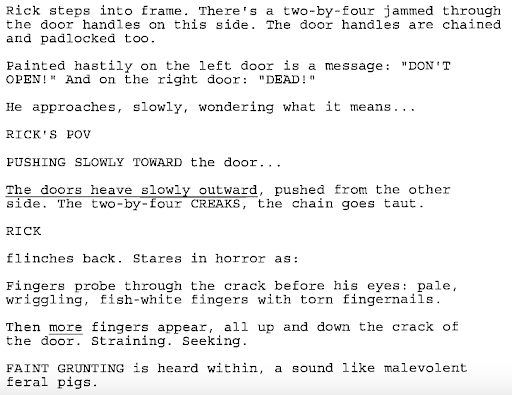
From the moment he wakes up, Rick follows clues that reveal that the dead are walking threats and his family is somewhere out there in danger. More clues are dropped on page 24 when Rick encounters people for the first time and they immediately want to know what kind of wound he has — now we can surmise that whatever affected the walkers is contagious.
He devises a plan to go to Atlanta to look for more help — not realizing that he’s walking into one of the worst places he could go.
Cliffhanger
A great TV pilot is different from a feature film, of course, in that it is the first episode of a long story, which means the ending must be satisfying while also leaving the reader begging for more. In this case, the reader journeys with Rick while knowing he’s heading into danger – which he finds, handily.
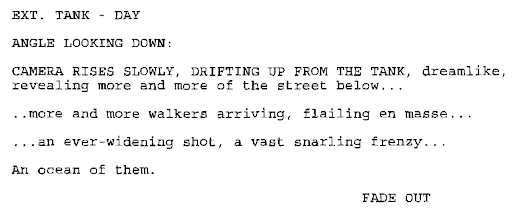
The episode ends with Rick trapped in a tank surrounded by “an ocean” of walkers, innately posing questions that a reader (and eventually a viewer) will want answers to: how will he escape his predicament, how will he find his family, and how will he survive in this new world?
Conclusion
The objective of a pilot screenplay is to capture the attention of your audience and keep them interested in this first episode as well as the entire run of the series. By cleanly building mystery and intrigue, keeping the pacing going, offering clean exposition and introductions to the world of the show, and ending on a high and compelling note, you’ll be well on your way toward standing out.
The Walking Dead is unique in that its pilot focuses centrally on one point of view and, therefore, one character: Rick. Darabont did not waste precious time giving in-depth character introductions to the rest of what would become an ensemble cast. This was a bold choice that paid off — most other pilots must also take time to give each character proper introductions.
What we can learn from this is that as long as the central story and character are compelling, the rest can come later. A pilot must work extra hard to serve the world and premise of the series.
With experience, we, as writers, learn where to spend our time in order to most effectively capture the attention of our readers.
Read More: Why Jesse Armstrong Won An Emmy: A ‘Succession’ Pilot Script Breakdown
 Shannon Corbeil is a writer, actor, and filmmaker in Los Angeles with recent appearances on SEAL Team and The Rookie. An Air Force veteran, her articles have been published in Business Insider, We Are The Mighty, and Military.com. She has written and produced hundreds of digital videos with millions of views. You can read more about her on her website or come play on Instagram and Twitter!
Shannon Corbeil is a writer, actor, and filmmaker in Los Angeles with recent appearances on SEAL Team and The Rookie. An Air Force veteran, her articles have been published in Business Insider, We Are The Mighty, and Military.com. She has written and produced hundreds of digital videos with millions of views. You can read more about her on her website or come play on Instagram and Twitter!

















